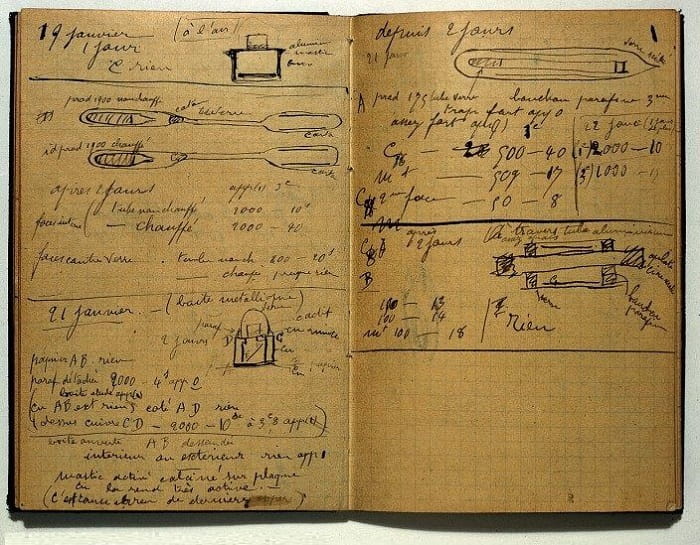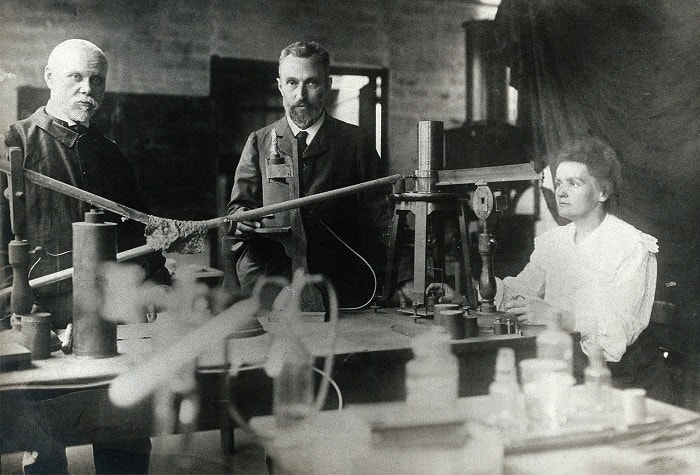Marie Curie’s discovery and isolation of radium with her husband, Pierre Curie, between 1898 and 1902, appears to be a very interesting story. “Marie Curie is, of all celebrated beings, the only one whom fame has not corrupted,” said Albert Einstein. Marie Carie Cancer Care, founded in 1948, further immortalized her name. The complex interaction she created between physics and chemistry alongside specific observations, skillful thinking, cutting-edge technology, brute force methods, extreme dedication, and luck factors led Marie Curie to be honored with two Nobel Prizes, the first in physics in 1903 and the second in chemistry in 1911.
Who was Marie Curie (Manya Sklodowska)?
Growing up in Warsaw has a huge stake in its success. Warsaw, the birthplace of Manya Sklodowska (Marie Curie’s name before marriage), remained under the strict rule of Russia throughout her youth. Many members of the Sklodowska family embarked on a revolt against the regime. Manya’s parents and teachers were prominent members of the unarmed, intellectual resistance. In her autobiography, Curie recalls that Russian instructors often treat Polish students as enemies.
Manya’s Polish patriotic fire was also the element that would define her entire career and instill in her character, consisting of determination to succeed, a thirst for knowledge, and moral beliefs. At the age of 10, her mother died of tuberculosis. “Thanks to her father, she lived in an intellectual atmosphere of rare quality known to few girls of her age,” wrote Marie’s second daughter, Eve Curie.
After graduating from school with a gold medal, Manya faced the lack of higher education options for women and the need to earn her living. Eventually, she accepted the job of governess for 3.5 years. The money she earned was going to her older sister, who studied medicine in Paris, and once her sister started to stand on her own two feet, Manya followed her steps.
A quality and challenging education

In 1891, she was one of 23 women who went to France to study at the Sorbonne Faculty of Science. But in her words about her student years, she never mentioned that her education took place in a male-dominated academic world. Also, Marie Curie never backed feminist groups that wanted her to be a role model for other women.
After three years of hard training, she passed the license es sciences exam in the first place and the license es mathematiques exam in the second place. One of the professors put her in touch with Pierre Curie, who was already well-known for his work on pressure electricity, or piezoelectricity, the electrical charge that builds up in certain solids like crystals, ceramics, and bones, and the effect of temperature on magnetism, in the hopes that Marie could continue her research with him.
The similarity between her past experiences in Poland and France was striking. They got married in 1895 and started working together after their first child’s birth (who would later win the Nobel) in 1897. Their handwriting in the laboratory notebooks followed each other in later years. The couple did not only have a constant exchange of ideas between them, but there was also an “energy exchange,” says Henri Poincare, “the definitive remedy for the temporary discouragements that every researcher faces.”
Henri Becquerel and uranium radiation
Henri Becquerel discovered uranium radiation in Paris in 1896 as he examined Wilhelm Röntgen’s recent discovery of the radiant effects of X-rays and certain substances. Becquerel took two thick black papers wrapped around the raw photographic plate and placed on them some light-emitting minerals in a thin crystal layer, then left the plates in the bright sun for hours. He thought that the paper would protect the plate from both light and fluorescence. However, he thought that “invisible fluorescence” could be seen as dark spots on the plate.
Using the uranium salt, he discovered that the paper passed the glow from the mineral: Part of the photo plate was blurred with the dark silhouette of the mineral layer. Therefore, he assumed that sunlight stimulates the spread of invisible rays from uranium. But then the days when the weather was cloudy intervened. Becquerel, in disappointment, took some of the uranium plates he had prepared and put them in his drawer in the laboratory.
Later, when he bathed in these films, he was in great shock. Contrary to his guess, he did not find very weak shadows from the uranium layer; instead, “the silhouettes appeared too intense.” “I thought the event was going on in the dark at the moment,” writes Becquerel. He discovered radioactivity (he would receive the Nobel Prize for Physics with the Curiosities in 1903 for his discovery), but he did not name this phenomenon nor did he explain it.
Sophisticated testing process

The Curies decided to investigate this new radiation phenomenon by putting various minerals through the most sensitive tests possible. Becquerel has shown that radioactivity not only affects photoplates but also discharges from electrified bodies. To detect this type of ionizing radiation, Pierre designed an extremely sensitive current-measuring device: an electrometer combined with a piezoelectric quartz balance. The tool consisted of a capacitor (ionization chamber), an electrometer to measure the differences in electrical potential, and quartz crystals to produce piezoelectricity (pressure electricity).
Piezoelectric crystals have the property of producing very small electrical polarization on the crystal surfaces under mechanical pressure. In this case, the pressure generated by small weights hanging under the crystal produced polarization. The powdered substance to be tested was spread in the form of a thin layer on the bottom tray of the condenser connected to one pole of the 100-volt accumulator. The upper tray was connected to one of the terminals of the electrometer, and the other terminal was connected to the top of the quartz crystal. (The bottom of the crystal was grounded to complete the electrical circuit, like the other pole of the accumulator.)
While Marie Curie was performing the process, the slow increase in the electric charge in both trays as a result of the ionization of the air in the condenser by the radiation of the substance was balanced with the increase in the electric charge produced by gradually adding weight to the quartz crystal. The balance point was determined by an electrometer. This was made of an aluminum sheet hanging on the conductive platinum wire with a small mirror underneath rotating around its axis; the ray of light falling on the rotating mirror produced a light point on the graduated glass scale. When this point fell to the midpoint of the scale (considered zero), the electric charge of the top tray of the capacitor and the piezoelectric quartz crystals were the same.
The trick was to keep the light spot in the center while the experiment was going on. Marie Curie must be standing still as much as possible while adding weights to the crystals with one hand, starting and stopping the stopwatch with the other hand, and constantly monitoring the light spot with her eyes. T time after the start of the experiment, the Q charge in the capacitor tray was equal to the charge in the crystal. The electric current caused by the radiation was equal to the electric charge per second at that point, i.e., Q/T.
In April 1898, Marie Curie reported alone while working: “All the minerals that demonstrate activity contain active elements.” Two minerals of uranium, pitchblende (a uranium oxide) and chalcolite (uranyl copper phosphate), are much more active than uranium itself. This fact is most remarkable and suggests that these minerals may contain an element much more active than uranium. While 52 millionths of a millionth of the chalcolithic amperes found in nature are producing current, 9 millionths of a millionth of the artificially produced chalcolite amperes are producing current.
Polonium, and radium
Of course, the second step was to try to isolate this unknown element. Although Pierre was a physicist rather than a chemist, he joined Marie full-time in her work. They had guessed that the isolation would take a few weeks. However, it took several years for them, especially Marie, to make it happen. Not only that, the isolation determined the flow of Marie’s whole life. With the help of a chemist colleague, the Curies developed a purification method and produced a 400-fold more active substance than uranium.
According to the result of the first chemical analysis and subsequent spectroscopic analysis, the presence of at least two new elements in the pitchblende ore was evident. In July 1898, they called the first element polonium, and in December, they named the second element radium. Their common article was titled “On a New Radioactive Substance Contained in Pitchblende”; it was the first scientific use of the term “radioactive.”
After purifying tons of pitchblende with heavy labor, the final product they obtained in 1902 was 0.1 grams—one-fifth of a small teaspoon—of pure radium chloride. However, this amount was sufficient for Marie to determine the atomic weight of radium as 225 and to place radium under barium in Dmitri Mendeleyeev‘s periodic table of alkaline earth metals.
Working with chemist Andre Debierne, who discovered the element actinium in pitchblende in 1899, he turned radium into a pure metal in 1910. Pure radium has become the standard for comparison with other radioactive materials, especially in beam therapy. Physical chemist and Nobel Prize winner Jean Perrin wrote in 1924: “It is not an exaggeration to say today that [the isolation of radium] is the cornerstone on which the entire edifice of radioactivity rests.”
How did Marie Curie die?

Pierre Curie’s death in 1906 as a result of a traffic accident in Paris was a painful blow that cast a shadow on Marie Curie’s life. But she never gave up his dedication to science. She was immediately appointed to replace Pierre as a professor and became the first woman to teach at the Sorbonne, where she studied. In 1914, Radium Institute laboratories were completed at the University of Paris under the direction of Marie Curie. Over time, it has become the universal center of nuclear physics and chemistry. Irene and Frederic Joliot-Curie made their artificial radioactivity discoveries here in 1934.
The applications of radioactivity in medicine made Marie increasingly busy; during World War I, she became the head of the French Radiology Service and even drove an ambulance carrying the x-ray machine to the frontlines. She died of leukemia in a sanatorium in Haute-Savoie at the relatively young age of 67. This was definitely because she had been exposed to a lot of radioactive things over the years.
Marie Curie quotes
“Nothing in life is to be feared, it is only to be understood. Now is the time to understand more, so that we may fear less.”
“All my life through, the new sights of Nature made me rejoice like a child.”
“There are sadistic scientists who hurry to hunt down errors instead of establishing the truth.”
“Life is not easy for any of us. But what of that? We must have perseverance and above all confidence in ourselves. We must believe that we are gifted for something and that this thing must be attained.”
I am among those who think that science has great beauty.”
Bibliography:
- Pasachoff, Naomi (1996). Marie Curie and the Science of Radioactivity. Oxford University Press. ISBN 978-0-19-509214-1.
- Quinn, Susan (1996). Marie Curie: A Life. Da Capo Press. ISBN 978-0-201-88794-5.
- Redniss, Lauren (2010). Radioactive: Marie & Pierre Curie: A Tale of Love and Fallout. HarperCollins. ISBN 978-0-06-135132-7.


